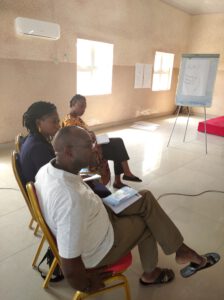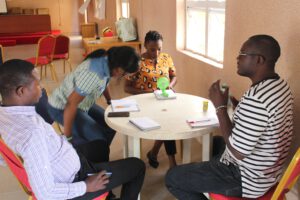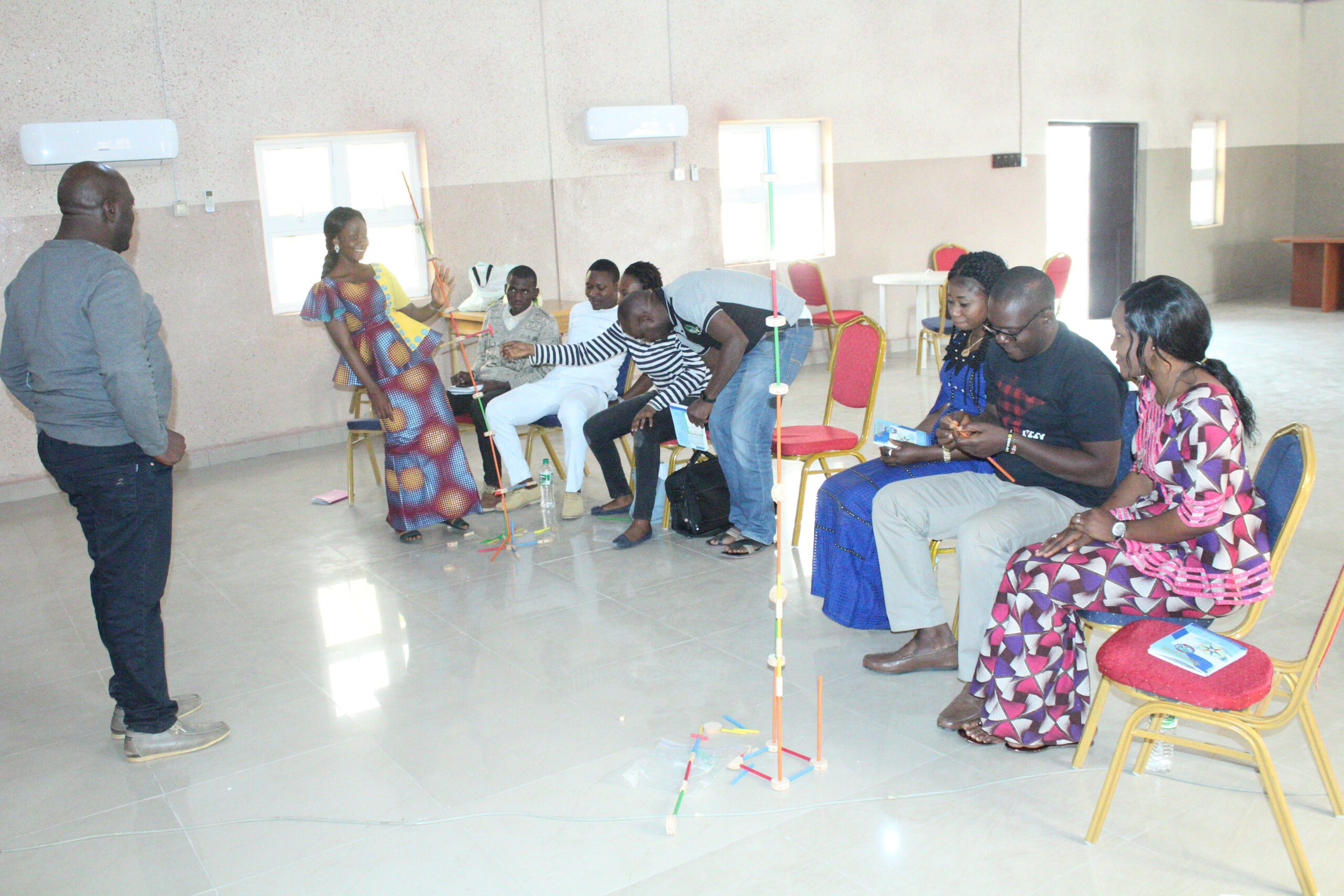Carefronting: Members of Sharing Education And Learning For Life (SELL) Foundation, Nigeria

Members of Sharing Education And Learning For Life (SELL) Foundation Nigeria SELL embarked on three days retreat with Carefronting Nigeria. All participants were exposed to various activities and training on trauma consciousness, resilience and self-care by Maji Peterx. Some of the topics and activities are detailed below
Trauma
There are various definitions of trauma but for this session we can say:
Trauma occurs when a person is overwhelmed by events or circumstances and responds with intense fear, horror, and helplessness. Extreme stress overwhelms the person’s capacity to cope….
Trauma trigger
A trauma trigger is a psychological stimulus that prompts recall of a previous traumatic experience. The stimulus itself need not be frightening or traumatic and may be only indirectly or superficially reminiscent of an earlier traumatic incident, such as a scent or a piece of clothing. [1] Triggers can be subtle and difficult to anticipate. A trauma trigger may also be called a trauma stimulus, a trauma stressor or a Trauma reminder. The process of connecting a traumatic experience to a trauma trigger is called traumatic coupling.
Avoiding a trauma trigger is a classic behavioral symptom of posttraumatic stress disorder (PTSD), a treatable and usually temporary condition in which people sometimes experience overwhelming emotional or physical symptoms when something reminds them of, or “triggers” the memory of, a traumatic event.
A trigger warning is a message presented to an audience about the contents of a book or other media, to warn them that it contains potentially distressing content.
Triggers
The trigger can be anything that provokes fear or distressing memories in the affected person, and which the associates with a traumatic experience. Some common triggers are:
Certain times of day – for example, sunset or sunrise
Certain times of year or specific dates – for example, autumn weather that resembles the affected person’s experience of the weather during the September attacks, or the anniversary of a traumatic experience
Sights– for example, a fallen tree or a light shining at a particular angle
Places – for example, a bathroom, or all bathrooms
A person, especially a person who was present during a traumatic event or resembles someone involved in that event in some respect
A particular odor – such as freshly mown grass, or the fragrance of an aftershave product
A particular taste – such as the food eaten during or shortly before a traumatic experience
A particular sound – such as a helicopter or a song
A sensation on the skin – such as the feeling of a wristwatch resembling the feeling of handcuffs, or sexual touching for victims of sexual assault
Physical pain
Emotions – such as feeling overwhelmed, vulnerable, or not in control
A particular situation – for example, being in a crowded place.
It has been suggested that the realistic portrayal of graphic violence in visual media may cause sufferers to encounter trauma triggers while watching movies or television.
Trigger warnings
Trigger warnings are warnings that a work contains writing, images, or concepts that may be distressing to some people.] Although it is widely recognized that any sight, sound, smell, taste, touch, feeling or sensation could be a trigger, trigger warnings are most commonly presented on a relatively narrow range of material, especially content about sexual abuse and mental illness (such as suicide, eating disorders , and self-injury ).

Some African therapy to handle trauma
Fambul Tok
Fambul Tok (Krio for “Family Talk”) emerged in Sierra Leone as a face-to-face community-owned program bringing together perpetrators and victims of the violence in Sierra Leone’s eleven-year civil war through ceremonies rooted in the local traditions of war-torn villages. It provides Sierra Leonean citizens with an opportunity to come to terms with what happened during the war, to talk, to heal, and to chart a new path forward, together.
Fambul Tok is built upon Sierra Leone’s “family talk” tradition of discussing and resolving issues within the security of a family circle. The program works at the village level to help communities organize ceremonies that include truth-telling bonfires and traditional cleansing ceremonies—practices that many communities have not employed since before the war. Through drawing on age-old traditions of confession, apology and forgiveness, Fambul Tok has revived Sierra Leoneans’ rightful pride in their culture.
Developed and first implemented by the Sierra Leonean human rights organization, Forum of Conscience, and the U.S.-based operating foundation, Catalyst for Peace, Fambul Tok incorporated as an international non-governmental organization, Fambul Tok International (FTI), in late 2009, with the program in Sierra Leone as its flagship project. Fambul Tok embodies the most leading-edge processes of consultative program design and “accompaniment” models of partnership—between in-country and outside organizations, as well as between implementing organizations and the communities of implementation. The program requires community ownership at every level. In so doing, it charts a new path for the international community in post-conflict reconstruction.
The Process
Fambul Tok is rooted in the understanding that reconciliation is a process and not a one-time event, and works with communities on a long-term basis. It ensures full community engagement—through initial consultations to determine whether people are ready to reconcile, and subsequently through community-led preparations and outreach for Fambul Tok ceremonies.
Following the ceremonies, Fambul Tok works with the communities to organize activities to support and sustain the reconciliation process. These have included radio-listening clubs, football games, and even village-initiated community farms—projects through which newly reconciled individuals come together for the good of the community.
Originally conceived as a chiefdom-level program that would involve 161 ceremonies around the country, Fambul Tok evolved to meet the needs of fellow Sierra Leoneans who have asked for ceremonies to be held at the much smaller level of village groupings—known as “sections“—that will involve thousands of ceremonies to be held over the next several years.
This community-healing process of reconciliation and forgiveness addresses the roots of conflict at the local level, and restores dignity to the lives of those who suffered most directly from violence. The work helps war-affected individuals reflect on the past and move forward in ways that avert the renewal of aggressions. By grounding reconciliation in traditional practices, it also helps create healthy communities capable of building new foundations of peace.
Fambul Tok is a distinctly Sierra Leonean initiative. It is not rooted in Western concepts of blame and retribution, but rather in African communal sensibilities that emphasize the need for communities to be whole, with each member playing a role, if peace and development are to be achieved for the nation at large.
Sierra Leone is entering a new era as the final phases of internationally driven institutions such as the Truth and Reconciliation Commission and the Special Court are coming to a close. Fambul Tok is stepping up to meet the demands of this new phase by broadening its campaign to all regions of Sierra Leone.
Palaver hut
African Palaver Huts In many African cultures, palaver huts serve as gathering places that provide a safe space to resolve conflict and build consensus among members of the community. The Truth and Reconciliation Commission of the Republic of Liberia (2009) described palaver huts as common to rural communities around the country, [and] is a conflict resolution mechanism wherein select members of integrity in the community adjudicate matters of grave concern to the community and seek to resolve disputes amongst or between individuals and or communities . Palaver huts are circular, open-air structures, usually made of mud, clay, or wood, with thatched roofs. The circular structure represents equality of all participants in the enclosure. The concept of African palaver is found in several African countries, each with varying degrees of structure and format of dialogue. However, commonalities of African palaver include the inclusive and collective nature of community discourse to address moral concerns, conduct confict resolution, create judicial laws, establish cultural norms, educate youth, welcome visitors, host social gatherings, and uplift the common good of the community.

Other forms of therapy to handle trauma
Fear therapy
Fear is an emotion that often occurs when someone feels they are in danger. While fear can be a healthy and safe response to certain situations, some mental health issues may cause a person’s fear response to activate more often or in situations that aren’t dangerous. Therapy can help people process feelings of fear that begin to affect their quality of life.
Managing and Overcoming Fear
Day-to-day fears may cause a person to experience some level of anxiety or panic. Feeling frightened can be an unpleasant experience, but attempting to completely suppress fearful emotions is not always a helpful solution. Instead, finding a distraction from fearful thoughts may bring some people relief.
Taking time to consider the fear rationally may also help people overcome certain fears, although this does not always help. People who experience fear caused by anxiety might know that one of their fears is irrational, but still may not be able to stop thinking or worrying about it.
Examining thoughts that are causing the fear can be a first step to addressing and overcoming it. Therapy can help people examine what is causing them to feel afraid and then process the underlying fearful beliefs or thoughts.
A person might also consider the following questions:
What am I afraid of?
Is this fear realistic?
What is the worst that can happen?
What can I do protect myself from that outcome?
Is the worst-case scenario really so disastrous?
Where in my body do I feel fear?
How do I feel when I take a few deep breaths?
Avoidance tends to make fear stronger. Meanwhile, slowly exposing oneself to objects and situations that cause fear may help reduce the level of fear experienced, helping a person overcome it.
The process may take time, and fear may persist, but support from family and friends can often be helpful. In the case of chronic fears or phobias, it may help to seek out a qualified therapist or mental health professional, as phobias and chronic fear can often interfere with well-being and typical daily function if left unaddressed.
How Therapy Can Help With Fear
Specific phobias, paranoia, and other intense fears may be debilitating. Sometimes, they may exist as the result of an underlying concern. When this is the case, the issue may often be addressed and examined in therapy. Therapy can support people in managing fear by helping them:
Understand what is causing their fear
Put fear into perspective
Set realistic expectations for the future
Persistent or intense fear may lead to anxiety,worry, stress, and other mental health concerns. Some people may be afraid of things that are unlikely to happen, such as being struck by lightning, while others may fear a more realistic threat, such as being mugged or burglarized. A person might fear many different things, and some people may feel afraid without knowing the cause of their fear at all. Talking to a therapist about your fears can help you clarify and resolve it.

Types of Therapy for Fear
Many therapeutic approaches can be used to help people overcome fear. Which strategy is used may depend on what is causing a person’s fear. Fear brought on by a phobia, fear caused by anxiety, fear brought on by a specific event, and fear with no known cause may require different approaches in therapy. Some common types of therapy for helping people manage fear include:
Exposure therapy: This type of therapy may prove helpful or empowering for people experiencing general feelings of fear or fear caused by obsessive compulsive disorder (OCD). Exposure therapy is typically conducted by exposing people to their fear gradually.
Cognitive behavioral therapy (CBT): CBT is one of the most often used approaches for helping people manage fear. It may also help people work through fear caused by anxiety, panic, OCD, and other mental health issues.
Eye movement desensitization and reprocessing (EMDR): EMDR may be particularly helpful for people whose feelings of fear are caused by past trauma.
Psychodynamic therapy: Psychodynamic therapy has been adapted to help people who experience panic to overcome fear. The approach utilizes the process of transference to address fear caused by panic.
People who often feel fearful may find that therapy can help them transform any maladaptive behaviors into positive thoughts and actions. Additionally, a therapist may also be able to teach those affected by fear how to recognize triggers for fear as well as the skills needed for effective fear management.
Art therapy
Art therapy involves the use of creative techniques such as drawing, painting, collage, coloring, or sculpting to help people express themselves artistically and examine the psychological and emotional undertones in their art. With the guidance of a credentialed art therapist, clients can “decode” the nonverbal messages, symbols, and metaphors often found in these art forms, which should lead to a better understanding of their feelings and behavior so they can move on to resolve deeper issues.
When It’s Used
Art therapy helps children, adolescents, and adults explore their emotions, improve self-esteem, manage addictions, relieve stress, improve symptoms of anxiety and depression, and cope with a physical illness or disability. Art therapists work with individuals, couples, and groups in a variety of settings, including private counseling, hospitals, wellness centers, correctional institutions, senior centers, and other community organizations. No artistic talent is necessary for art therapy to succeed, because the therapeutic process is not about the artistic value of the work, but rather about finding associations between the creative choices made and a client’s inner life. The artwork can be used as a springboard for reawakening memories and telling stories that may reveal messages and beliefs from the unconscious mind.
Natural response to trauma
How to Recognize Fight, Flight and Freeze,
The fight-flight-freeze response choice has a lot to do with your beliefs. If you believe you can conquer the danger, your body will jump into fight mode. But if you believe there’s no hope of defeating the attacker, you’ll naturally respond by running away.
When you respond by freezing, it usually indicates you feel you can’t win either by fighting or running. The fawn response can happen when you can’t fight or run. Instead, you choose to go along, trying to win over a person who is abusing you. It’s one thing to understand the responses you might have when you feel threatened. What can help the most is being able to recognize each type of response. Only then can you find a way to make better choices.
Fight
The fight response happens when you feel you’re in danger, but you believe you can overpower the threat. Your brain sends messages to your body to quickly prepare you for the physical demands of fighting. Some signs you’re in fight mode include:
You cry
You feel like punching someone or something
Your jaw is tight, or you grind your teeth
You glare at people or talk to them with anger in your voice
You feel like stomping or kicking
You feel intense anger
You feel like killing someone, perhaps even yourself
Your stomach feels tied in knots, or you have a burning feeling in your stomach
You’ll also know if you’re in fight mode because you’ll attack the source of the danger. The fight response can be extremely beneficial under certain circumstances.
Flight
When you believe you can overcome the danger by running away, your brain prepares your body for flight. Sometimes, running away is your best option. After all, unless you’re a firefighter, you probably want to run out of a burning building. Here are some of the emotional and physical flight responses:
Your legs are restless
You feel numbness in your extremities
Your eyes dilate and dart around
You constantly move your legs and feet
You’re fidgety
You’re tense
You feel trapped
You exercise excessively
Source: unsplash.com
Freeze
When you feel neither running nor fighting is the best choice, you can freeze instead. The following freeze responses can keep you stuck:
You feel cold
You have numbness in your body
Your skin is pale
You feel stiff or heavy
You have a sense of dread
Your heart is pounding
Your heart rate may decrease
You feel yourself tolerating the stress.



